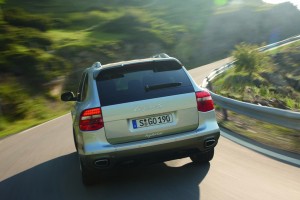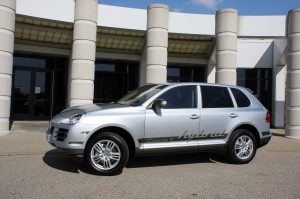
The Porsche Cayenne S Hybrid is expected to deliver about 28% better mileage than the standard Cayenne V-6, but will match the performance of the SUV with a big V-8.
The Porsche Cayenne has always struck some folks as a bit of an oxymoron, but the German maker has arguably done as good a job as any manufacturing putting the “sport” back in sport-utility vehicle. Now, however, Porsche is going a step further, and with the upcoming launch of its 2011 Cayenne S Hybrid, it hopes to prove that an SUV can be mean and green.
Though the hybrid-electric vehicle, or HEV, is still about a year away from production, we were given a chance to log some miles when Dr. Michael Leiters, the project’s program manager, rolled into town with one of his first prototypes.
At first glance, you’d not spot anything different about the 2011 Porsche Cayenne S Hybrid – not unless you’d parked on a scale, where it would weigh in about 400 pounds more than the base Cayenne V-6. Considering all that the carmaker has packed into the various nooks and crannies of the big ute, that’s not as much as you might expect.
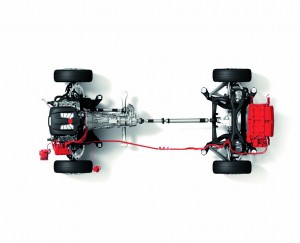
The big battery pack - in back - electric motor, control system and disengagement clutch all add about 400 pounds compared to the weight of a comparably-powered Cayenne V-8.
The primary engine in the new HEV is an Audi-derived 3.0-liter Direct-Injection V6 making 333 horsepower. The system pairs it with a 52 horsepower (38 kw) electric motor, powered by a 288-volt Nickel-Metal Hydride battery. (The source of much of the extra weight, it is mounted back by the rear axle, where the spare tire would normally sit.)
In typical fashion, Porsche decided to blaze its own trail. While other hybrid manufacturers have generally opted for CVT-style transmissions – such as Toyota’s Hybrid Synergy Drive – the German marque is using a new 8-speed automatic gearbox, derived from the Cayenne’s standard-issue 6-speed.
Where a system using a CVT can smoothly balance the loads between gasoline engine and electric motor, Porsche needed to come up with an alternative way to link or disconnect the two sources of power. A so-called disengagement clutch allows them to spin separately and at different speeds, claims Leiters, improves not only performance but also fuel economy.
“Our conviction is that this system fits better with Porsche,” says the project manager. “The CVTs in a power-split systems (like Porsche) create a rubber-band effect,” Leiters notes, referring to that unnatural sensation when the engine starts racing, but the vehicle takes a few seconds to seemingly catch up, like a stretched elastic. “Here, you have the feeling of normal shifts. It feels more sporty and more typical for Porsche.”
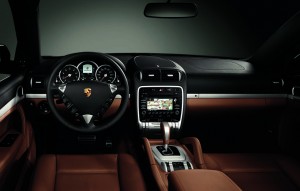
The navigation screen and central display between the speedo and tach do double-duty, indicating the performance mode of the hybrid drive system.
And, indeed, as we headed out from the Automotive Hall of Fame parking lot, in Dearborn, Michigan, we might quickly have forgotten that we were driving a hybrid were it not for the video monitor on the center console – and Leiters’ ongoing explanation as the 2011 Porsche Cayenne S Hybrid shifted gears and operating modes.
The HEV is, in fact, a “full” hybrid, which means that it can run, at speeds up to 32 mph, in battery-only mode – for a maximum of a little over a mile if the NiMH pack is fully charged. The Hybrid also will briefly coast, with engine idled, at speeds up to 86 mph, further reducing fuel consumption. Come to a stoplight and, under normal conditions, the V-6 will shutdown until you lift your foot off the brake when it’s time to go again. The battery can be recharged by recapturing energy during braking or coasting, or if necessary, by putting the gasoline engine into generator mode.
Under routine driving, you’ll likely see the gasoline engine do much of the lifting. Stomp hard on the throttle, however, and both sources of power come to life, the electric motor acting as a sort of battery-powered supercharger.
In terms of sportiness, asserts Leiters, the Hybrid “has performance like the V-8.” On the freeway, it accelerated quickly and smoothly, shifts occurring almost transparently. On local roads, the word “serene” might come to mind. The only glitch occurred as we got off the Southfield Freeway and the computer controlling the complex hybrid system downshifted at the same moment it changed driving modes. Even then, the slight hesitation might have gone without notice if we weren’t in test drive mode.
According to preliminary Porsche data, the 2011 Cayenne S Hybrid will deliver a solid 374 horsepower when you factor in both electric and gasoline power sources. (It’s not a simple matter of adding the two up.) That compares to 385 hp for the regular Cayenne S and 500 for the Cayenne Turbo. The Hybrid generates a maximum 406 pound-feet of torque, somewhere in the middle of the three. And it will launch from 0 to 60 in 6.5 seconds, just a tenth slower than the standard-issue Cayenne S. Top speed is 149 mph, or 6 mph slower than the V-6.
Of course, there’s another figure that matters, and that’s fuel economy. Initial measurements done to the U.S. government’s test cycle, yielded 27 miles per gallon, compared to 21 for the V-6 Cayenne. But the figures are always adjusted to reflect real-world driving conditions, so Porsche is cautiously predicting they will come in at 24 mpg in the combined City/Highway cycle. That would be a 28% improvement over the standard Cayenne V-6.
The Porsche hybrid system is complex. According to Leiters, the Cayenne V-6 has about 5,000 parts numbers, but the 2011 Porsche Cayenne S Hybrid will have close to 25,000. How much extra that will cost, no one at the company is willing to say, yet, but despite the additional parts, Leiters insists that the Porsche hybrid design is “significantly cheaper (and) cost-efficient” than systems like the Hybrid Synergy Drive. If so, Porsche might keep its premium to only a couple thousand dollars more than the comparable gas-only Cayenne S.
How big a market is there? That could determine the price tag, of course, since volume impacts component pricing. It will also influence planned upgrades to the system. Leiters says Porsche is already working with a next-generation Lithium-Ion battery pack. That would boost available power by at least a third, which would translate into more time operating in electric mode and even better fuel economy.
If the 2011 Porsche Cayenne S Hybrid lives up to initial expectations, it could silence critics who look at the ute as an exercise in excess. The technology would also help Porsche address upcoming increases in fuel economy regulations, both here and abroad. (Though both U.S. and European regulators have given Porsche and other small luxury makers several extra years to meet the planned 35.5 mpg standard otherwise set for 2016.)
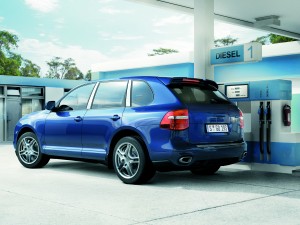
Porsche is still unsure whether there would be a U.S. market for the Cayenne Diesel it's now selling in Europe and other parts of the world.
The new hybrid drivetrain was sized specifically so it could be shared, revealed Leiters, with the new Panamera, Porsche’s first 4-door sports car. An HEV version could be out by 2012 or 2013, according to sources.
Of course, there are other ways to address the mileage issue, and the German maker also brought a prototype diesel to Dearborn. The Cayenne oil-burner already is on sale in Western Europe, Russia, Australia and even South Africa, but for the moment, the company just isn’t sure whether it can find enough demand to justify the added cost of bringing the Cayenne diesel into compliance with the latest California emissions standards.
“But if American consumers change their minds,” and begin to embrace diesels, suggests Leiters, “it would be easy to bring to market.” How soon, he isn’t saying, but a hint of smile crept over his face when asked if 2012 or 2013 is a reasonable target.
Until then, mileage-minded motorists who still want the power, performance and capacity of a sport-ute will have to settle for the 2011 Cayenne S Hybrid.

